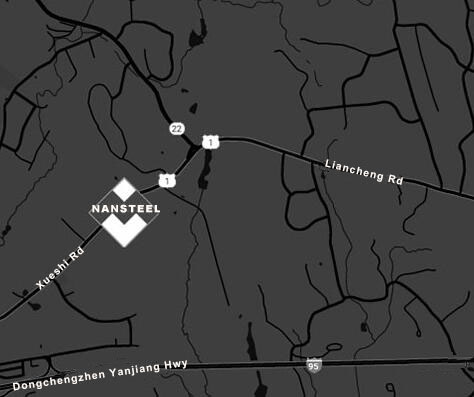Thin-walled seamless steel pipes offer significant advantages in many fields due to their unique manufacturing process and structural properties. They combine the high strength and weld-free nature of seamless steel pipes with the lightweight and high efficiency benefits of thin walls. Nansteel Manufacturing Co., Ltd. has carefully summarized the six major advantages and applications of thin-walled seamless steel pipes.
6 advantages of thin-walled seamless steel pipes
The advantages of thin-walled seamless steel pipes can be summarized into the following six aspects, which include both the performance advantages of the material itself and the comprehensive benefits brought by engineering applications.
1. Lightweight and material-saving
This is the most direct advantage of thin-walled steel pipes. Compared to thick-walled steel pipes, thin-walled pipes use less material and are therefore lighter. This reduced wall thickness can reduce weight per unit length by 55%–60%, thereby lowering transportation, lifting, and support costs. Under the same pressure conditions, direct material costs can be saved by 40%–50% compared to thick-walled pipes.
2. High strength and safety
Using high-alloy steel such as 304/316L or Q345B low-alloy high-strength steel, the yield strength can reach 1.5-2 times that of ordinary carbon steel. The dimensional accuracy and bending and torsional resistance are further improved through cold drawing and cold rolling processes.
3. Corrosion resistant and long life
Stainless steel thin-walled seamless pipes still have excellent passivation film protection in humid, acidic, alkaline and high chloride ion environments. The design life can reach 70 years, and the average annual amortization cost is significantly lower than that of galvanized pipes.

4. Convenient construction and high efficiency
Light weight and flexible connection methods such as clamping/ring pressing improve on-site installation efficiency by approximately 50% and reduce labor costs; the reduced wall thickness increases the diameter, allowing installation in narrow pipe shafts or suspended ceilings, improving building space utilization.
5. High Precision and Easy Processing
The cold-drawing process ensures tight tolerances on outer diameter and wall thickness, meeting the stringent dimensional consistency and surface quality requirements of the hydraulics, pneumatics, automotive, and aerospace industries. It also facilitates secondary processing such as bending, flaring, and welding.
6. Environmentally friendly and recyclable
Steel is 100% recyclable. Thinner steel reduces the consumption of ore and alloying elements, aligning with the "lightweight and low-carbon" development trend in industries such as construction and automotive.
Application areas
Because of these advantages, thin-walled seamless steel pipes are widely used in the following fields:
Automotive Industry: Manufacturing drive shafts, shock absorber piston rods, exhaust pipes, etc.
Hydraulic Systems: High precision and high pressure resistance are critical for hydraulic cylinders and high-pressure oil lines.
Aerospace: Used in the manufacture of high-strength, lightweight structural components and fluid transport pipelines for aircraft.
Medical devices: Components used in the manufacture of precision instruments place extremely high demands on material cleanliness and dimensional accuracy.
Heat exchangers: As heat exchange tubes, their efficient thermal conductivity improves equipment efficiency.
Read more: Seamless Steel Pipe vs Spiral Steel Pipe
6 advantages of thin-walled seamless steel pipes
The advantages of thin-walled seamless steel pipes can be summarized into the following six aspects, which include both the performance advantages of the material itself and the comprehensive benefits brought by engineering applications.
1. Lightweight and material-saving
This is the most direct advantage of thin-walled steel pipes. Compared to thick-walled steel pipes, thin-walled pipes use less material and are therefore lighter. This reduced wall thickness can reduce weight per unit length by 55%–60%, thereby lowering transportation, lifting, and support costs. Under the same pressure conditions, direct material costs can be saved by 40%–50% compared to thick-walled pipes.
2. High strength and safety
Using high-alloy steel such as 304/316L or Q345B low-alloy high-strength steel, the yield strength can reach 1.5-2 times that of ordinary carbon steel. The dimensional accuracy and bending and torsional resistance are further improved through cold drawing and cold rolling processes.
3. Corrosion resistant and long life
Stainless steel thin-walled seamless pipes still have excellent passivation film protection in humid, acidic, alkaline and high chloride ion environments. The design life can reach 70 years, and the average annual amortization cost is significantly lower than that of galvanized pipes.

4. Convenient construction and high efficiency
Light weight and flexible connection methods such as clamping/ring pressing improve on-site installation efficiency by approximately 50% and reduce labor costs; the reduced wall thickness increases the diameter, allowing installation in narrow pipe shafts or suspended ceilings, improving building space utilization.
5. High Precision and Easy Processing
The cold-drawing process ensures tight tolerances on outer diameter and wall thickness, meeting the stringent dimensional consistency and surface quality requirements of the hydraulics, pneumatics, automotive, and aerospace industries. It also facilitates secondary processing such as bending, flaring, and welding.
6. Environmentally friendly and recyclable
Steel is 100% recyclable. Thinner steel reduces the consumption of ore and alloying elements, aligning with the "lightweight and low-carbon" development trend in industries such as construction and automotive.
Application areas
Because of these advantages, thin-walled seamless steel pipes are widely used in the following fields:
Automotive Industry: Manufacturing drive shafts, shock absorber piston rods, exhaust pipes, etc.
Hydraulic Systems: High precision and high pressure resistance are critical for hydraulic cylinders and high-pressure oil lines.
Aerospace: Used in the manufacture of high-strength, lightweight structural components and fluid transport pipelines for aircraft.
Medical devices: Components used in the manufacture of precision instruments place extremely high demands on material cleanliness and dimensional accuracy.
Heat exchangers: As heat exchange tubes, their efficient thermal conductivity improves equipment efficiency.
Read more: Seamless Steel Pipe vs Spiral Steel Pipe









